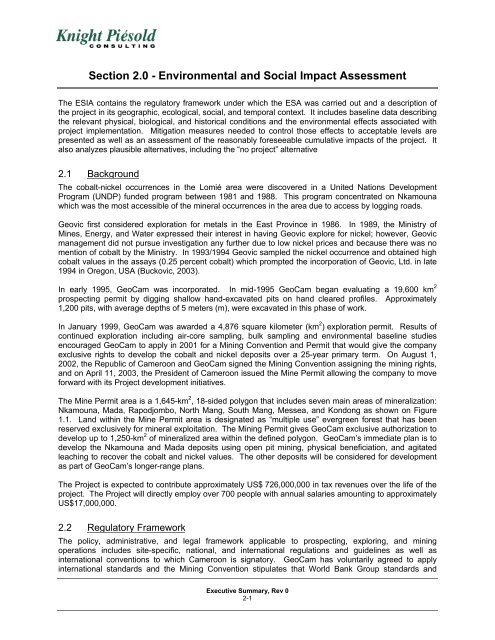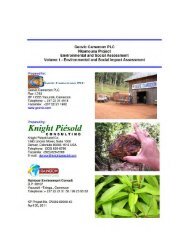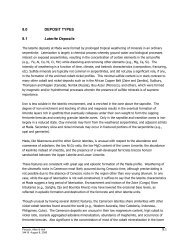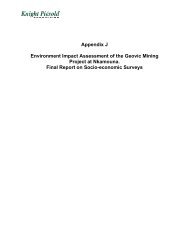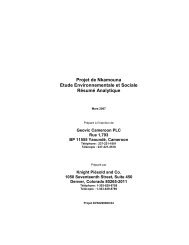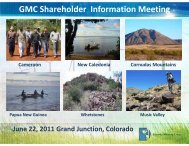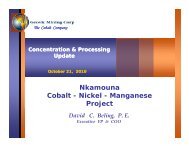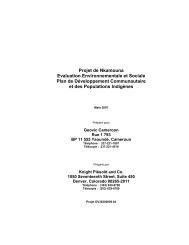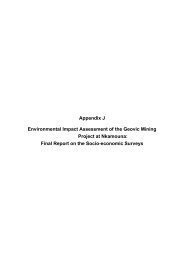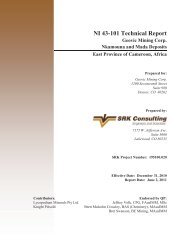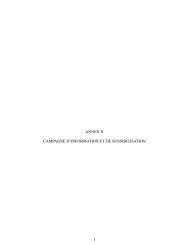Nkamouna Project Environmental & Social Assessment Executive ...
Nkamouna Project Environmental & Social Assessment Executive ...
Nkamouna Project Environmental & Social Assessment Executive ...
Create successful ePaper yourself
Turn your PDF publications into a flip-book with our unique Google optimized e-Paper software.
Section 2.0 - <strong>Environmental</strong> and <strong>Social</strong> Impact <strong>Assessment</strong>The ESIA contains the regulatory framework under which the ESA was carried out and a description ofthe project in its geographic, ecological, social, and temporal context. It includes baseline data describingthe relevant physical, biological, and historical conditions and the environmental effects associated withproject implementation. Mitigation measures needed to control those effects to acceptable levels arepresented as well as an assessment of the reasonably foreseeable cumulative impacts of the project. Italso analyzes plausible alternatives, including the “no project” alternative2.1 BackgroundThe cobalt-nickel occurrences in the Lomié area were discovered in a United Nations DevelopmentProgram (UNDP) funded program between 1981 and 1988. This program concentrated on <strong>Nkamouna</strong>which was the most accessible of the mineral occurrences in the area due to access by logging roads.Geovic first considered exploration for metals in the East Province in 1986. In 1989, the Ministry ofMines, Energy, and Water expressed their interest in having Geovic explore for nickel; however, Geovicmanagement did not pursue investigation any further due to low nickel prices and because there was nomention of cobalt by the Ministry. In 1993/1994 Geovic sampled the nickel occurrence and obtained highcobalt values in the assays (0.25 percent cobalt) which prompted the incorporation of Geovic, Ltd. in late1994 in Oregon, USA (Buckovic, 2003).In early 1995, GeoCam was incorporated. In mid-1995 GeoCam began evaluating a 19,600 km 2prospecting permit by digging shallow hand-excavated pits on hand cleared profiles. Approximately1,200 pits, with average depths of 5 meters (m), were excavated in this phase of work.In January 1999, GeoCam was awarded a 4,876 square kilometer (km 2 ) exploration permit. Results ofcontinued exploration including air-core sampling, bulk sampling and environmental baseline studiesencouraged GeoCam to apply in 2001 for a Mining Convention and Permit that would give the companyexclusive rights to develop the cobalt and nickel deposits over a 25-year primary term. On August 1,2002, the Republic of Cameroon and GeoCam signed the Mining Convention assigning the mining rights,and on April 11, 2003, the President of Cameroon issued the Mine Permit allowing the company to moveforward with its <strong>Project</strong> development initiatives.The Mine Permit area is a 1,645-km 2 , 18-sided polygon that includes seven main areas of mineralization:<strong>Nkamouna</strong>, Mada, Rapodjombo, North Mang, South Mang, Messea, and Kondong as shown on Figure1.1. Land within the Mine Permit area is designated as “multiple use” evergreen forest that has beenreserved exclusively for mineral exploitation. The Mining Permit gives GeoCam exclusive authorization todevelop up to 1,250-km 2 of mineralized area within the defined polygon. GeoCam’s immediate plan is todevelop the <strong>Nkamouna</strong> and Mada deposits using open pit mining, physical beneficiation, and agitatedleaching to recover the cobalt and nickel values. The other deposits will be considered for developmentas part of GeoCam’s longer-range plans.The <strong>Project</strong> is expected to contribute approximately US$ 726,000,000 in tax revenues over the life of theproject. The <strong>Project</strong> will directly employ over 700 people with annual salaries amounting to approximatelyUS$17,000,000.2.2 Regulatory FrameworkThe policy, administrative, and legal framework applicable to prospecting, exploring, and miningoperations includes site-specific, national, and international regulations and guidelines as well asinternational conventions to which Cameroon is signatory. GeoCam has voluntarily agreed to applyinternational standards and the Mining Convention stipulates that World Bank Group standards and<strong>Executive</strong> Summary, Rev 02-1


